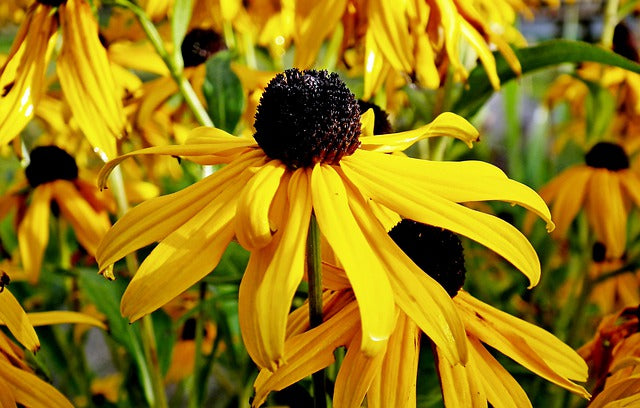Few flowers catch sunlight like Rudbeckia. With their bold, daisy-like blooms in bright yellow, gold, and orange, these cheerful perennials and annuals bring warmth and energy to garden beds long after many plants have faded. Their iconic dark cones surrounded by golden petals give them their common name: Black-eyed Susan.
But Rudbeckia offers more than just beauty. These native North American plants are resilient, pollinator-friendly, and incredibly easy to grow. Whether planted en masse or tucked among grasses and coneflowers, they bring a burst of wild beauty to both formal and naturalistic gardens.

Portrait of Rudbeckia
Rudbeckia is a genus in the Asteraceae family, with popular species like Rudbeckia hirta and Rudbeckia fulgida. They are staples in prairie gardens and native landscapes.
- Type: Herbaceous perennial or biennial (some annuals)
- Family: Asteraceae
- Common Names: Rudbeckia, Black-eyed Susan, Coneflower
Foliage and Form
Rudbeckia plants form upright clumps with rough, lance-shaped leaves. Their sturdy stems support large, sun-catching flowers that stay vibrant even in heat.
- Height: 45–120 cm (1.5–4 ft)
- Spread: 30–60 cm (1–2 ft)
- Growth Habit: Upright, bushy, with moderate self-seeding
Blooms and Fragrance
These are classic summer-to-fall bloomers, loved by bees, butterflies, and birds alike.
- Bloom Time: Mid-summer to early fall
- Color: Yellow, orange, gold with dark brown or black centers
- Fragrance: Mild to none
The Right Time to Plant, Prune, and Enjoy Rudbeckia
| Month | Planting | Flowering | Pruning |
|---|---|---|---|
| January | ❌ | ❌ | ✅ Cut back dead growth |
| February | ✅ Indoors (seed starting) | ❌ | ✅ Light cleanup |
| March | ✅ Direct sow in mild zones | ❌ | ✅ Remove winter debris |
| April | ✅ Best transplant time | ❌ | ❌ |
| May | ✅ | ✅ Begins in some zones | ❌ |
| June | ❌ | ✅ Peak bloom | ✅ Deadhead for more flowers |
| July | ❌ | ✅ Peak continues | ✅ Remove spent flowers |
| August | ❌ | ✅ High bloom | ✅ Light shaping |
| September | ✅ (Fall planting possible) | ✅ Late blooms | ✅ Cut back faded stems |
| October | ✅ (Container plants) | ❌ | ✅ Prepare for dormancy |
| November | ✅ (Zones 8–10) | ❌ | ✅ Final clean-up |
| December | ❌ | ❌ | ✅ Remove dead stems |
✅ = Recommended ❌ = Not advised
Watering, Sunlight, and Environment for Rudbeckia
Watering
While young plants appreciate regular watering, mature Rudbeckias are drought-tolerant and low-maintenance.
- When to Water: Weekly until established
- How Much: 2.5 cm (1 inch) per week
- Watch out for: Overwatering in poorly draining soil
Sunlight
These flowers thrive in full sun, rewarding you with better blooms the more light they receive.
- Ideal Exposure: 6–8 hours of sun per day
- Too Little Sun: Fewer flowers, more foliage
- Shady Sites: Leggy growth and poor blooming
Indoor vs Outdoor
Rudbeckia is strictly an outdoor plant. It needs space and sunlight to perform well.
- Best Location: Flower beds, borders, native meadows
- Avoid: Indoors or in tight containers
Temperature
These hardy plants tolerate both heat and cold, making them ideal for most gardens.
- Optimal Range: 15–30°C (59–86°F)
- Hardiness Zones: USDA 3–9
- Protection Tip: Mulch in cold zones to insulate roots
Ideal Soil Conditions for Growing Rudbeckia
| Soil Feature | Optimal Condition | Why It Matters |
|---|---|---|
| Soil Type | Loamy or sandy soil | Ensures drainage and root health |
| Texture | Loose, crumbly | Supports strong root spread |
| Drainage | Well-draining | Prevents fungal problems |
| Moisture | Moist to dry once established | Reduces disease, encourages root depth |
| Soil pH | Neutral to slightly acidic (6.0–7.0) | Optimizes nutrient availability |
| Fertility | Moderate | Too much fertility = floppy stems |
Common Problems & Solutions
| Issue 🐾 | Symptoms 🔍 | Solutions 🛠️ |
|---|---|---|
| Powdery Mildew 🌫️ | White coating on leaves | Improve spacing and airflow |
| Leaf Spots 🍂 | Brown/black dots on foliage | Remove infected leaves, avoid overhead watering |
| Aphids 🐜 | Sticky residue, stunted growth | Spray with insecticidal soap or neem oil |
| Deer 🦌 | Chewed flowers or foliage | Use repellents or fencing |
| Self-Seeding 🌱 | Spreads aggressively | Deadhead to control reseeding |
Rudbeckia brings golden joy to the garden, glowing in the late-summer sun and waving gently in the breeze. Tough yet radiant, this is the flower to plant if you want color, pollinators, and low effort rolled into one dependable plant. Perfect for wildflower beds, cutting gardens, or just a splash of sunshine in any corner of your landscape.